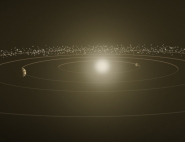CNES projects library
C
I
M
P
S
U
Bi
Cluster
Since mid-2010, instruments on the Cluster mission’s four satellites—Samba, Tango, Rumba and Salsa—have been directed at the Earth’s magnetic shield, monitoring its interactions with the solar wind that strikes it at 400km/s. Typically spanning several hundred to several tens of thousands of kilometres, these interactions are the source of the magnetic storms that can cause damage to telecommunications systems and even to ground-based electrical power grids.
Each satellite in the Cluster mission is equipped with an identical suite of 11 instruments, three of which were funded by CNES and developed and built by French research laboratories (IRAP, LPC2E, LPP, LESIA). This complex instrumentation makes it possible to distinguish spatial and temporal variations and to refine models of interactions between the different regions of Earth’s environment. Distances between the satellites vary from 600 to 20,000 km, depending on which regions they’re crossing and their current scientific objective.
The Cluster mission experienced some bad luck at the start, when its four satellites were lost on Ariane 5’s failed maiden flight in 1996. However, as the primary cornerstone—along with SOHO—of the European Space Agency’s (ESA) Horizon 2000 programme, the Cluster mission was extended and new flight models identical to the previous ones were constructed .
Mission's news feed
-

Cluster’s 20 years of studying Earth’s magnetosphere
Despite a nominal lifetime of two years, ESA’s Cluster is now entering its third decade in space and still enabling new discoveries as it explores our planet’s relationship with...
August 17, 2020
-

ESA scales down science mission operations amid pandemic
In response to the escalating coronavirus pandemic, ESA has decided to further reduce on-site personnel at its mission control centre in Darmstadt, Germany.
March 24, 2020
-

Solar storms impact Earth’s neighbourhood
Fifteen years after they were first acquired, data from the Cluster mission continue to reveal new insights into the disturbances generated by solar storms when they hit Earth’s...
December 16, 2019


